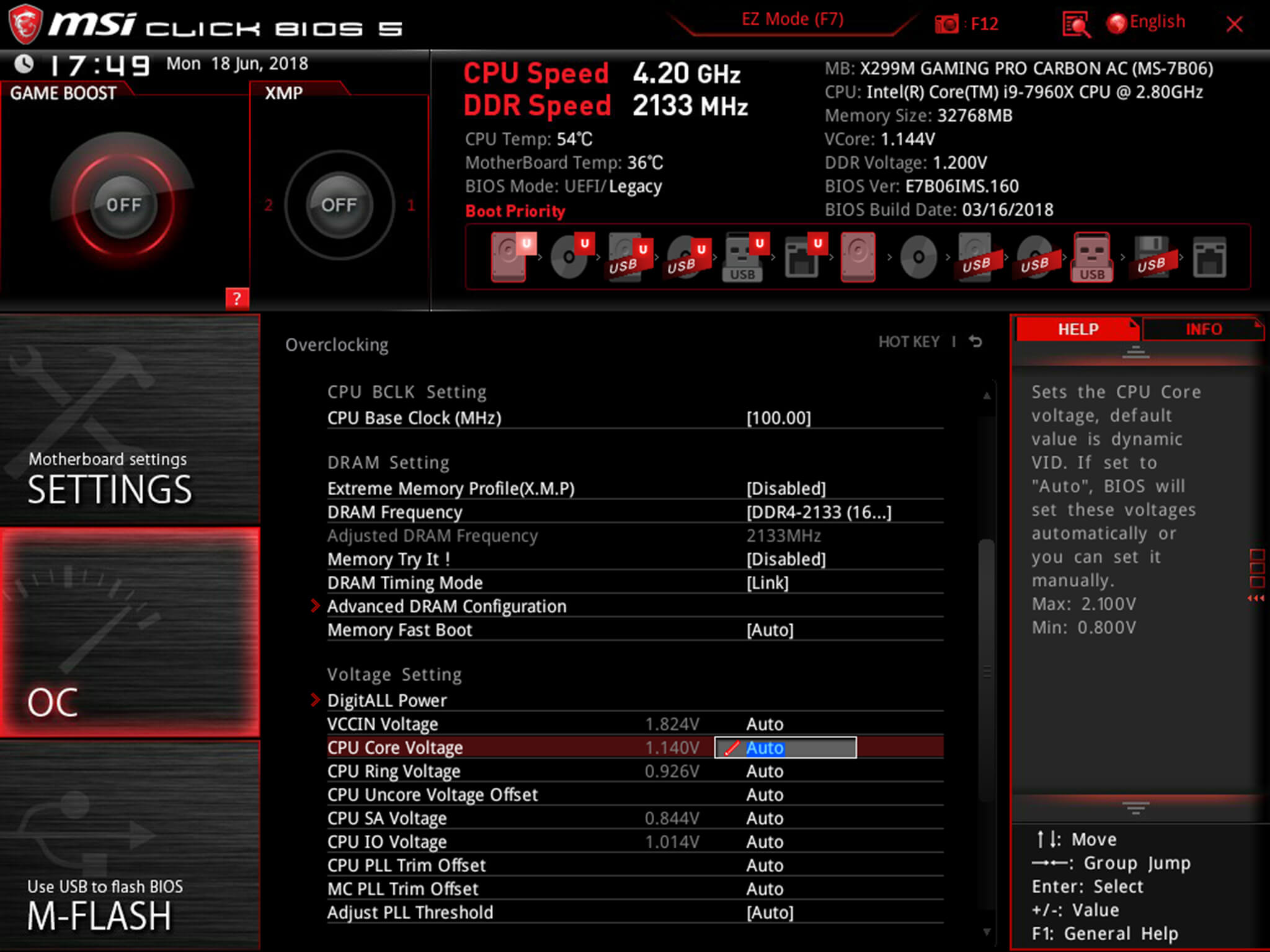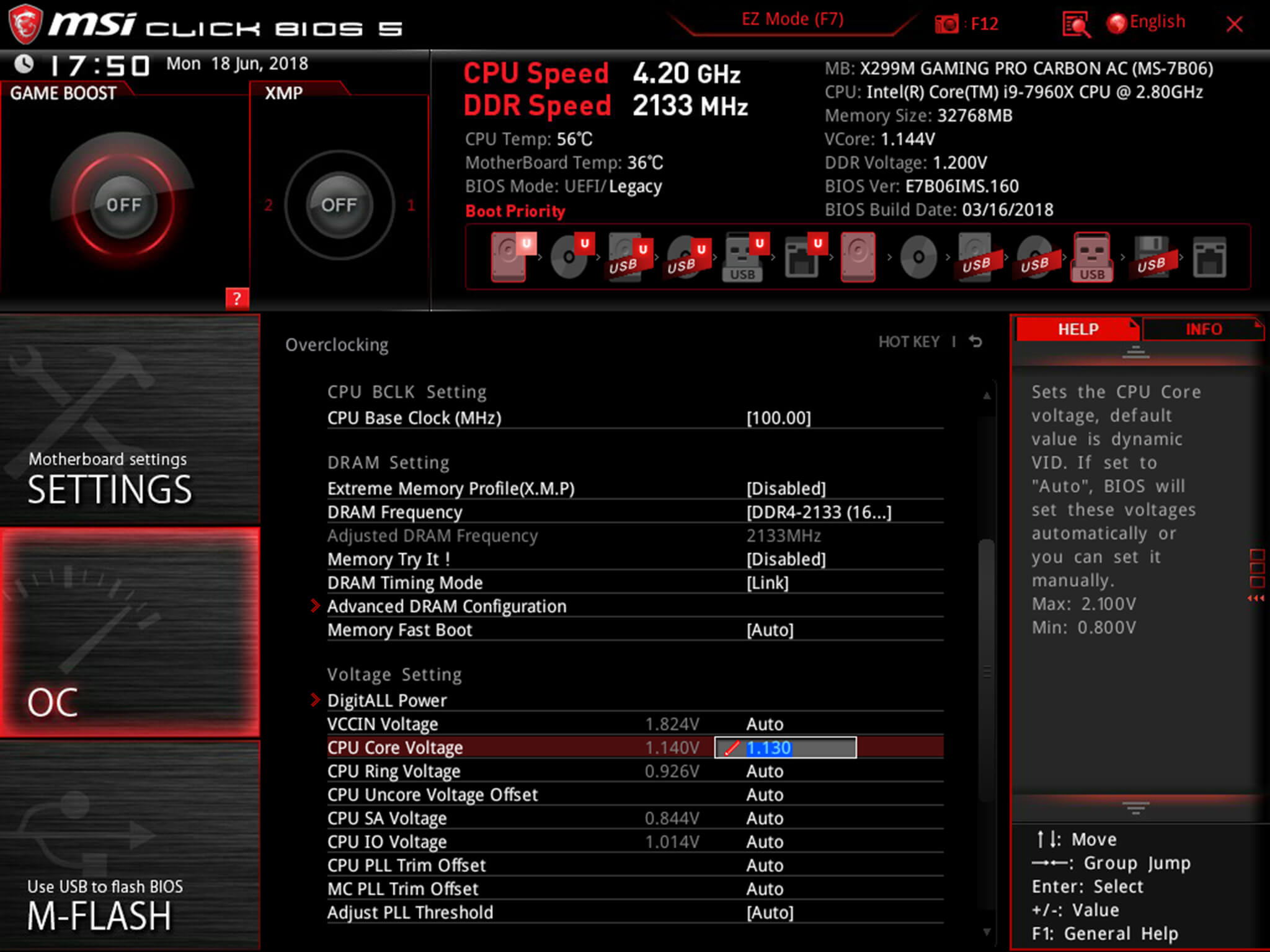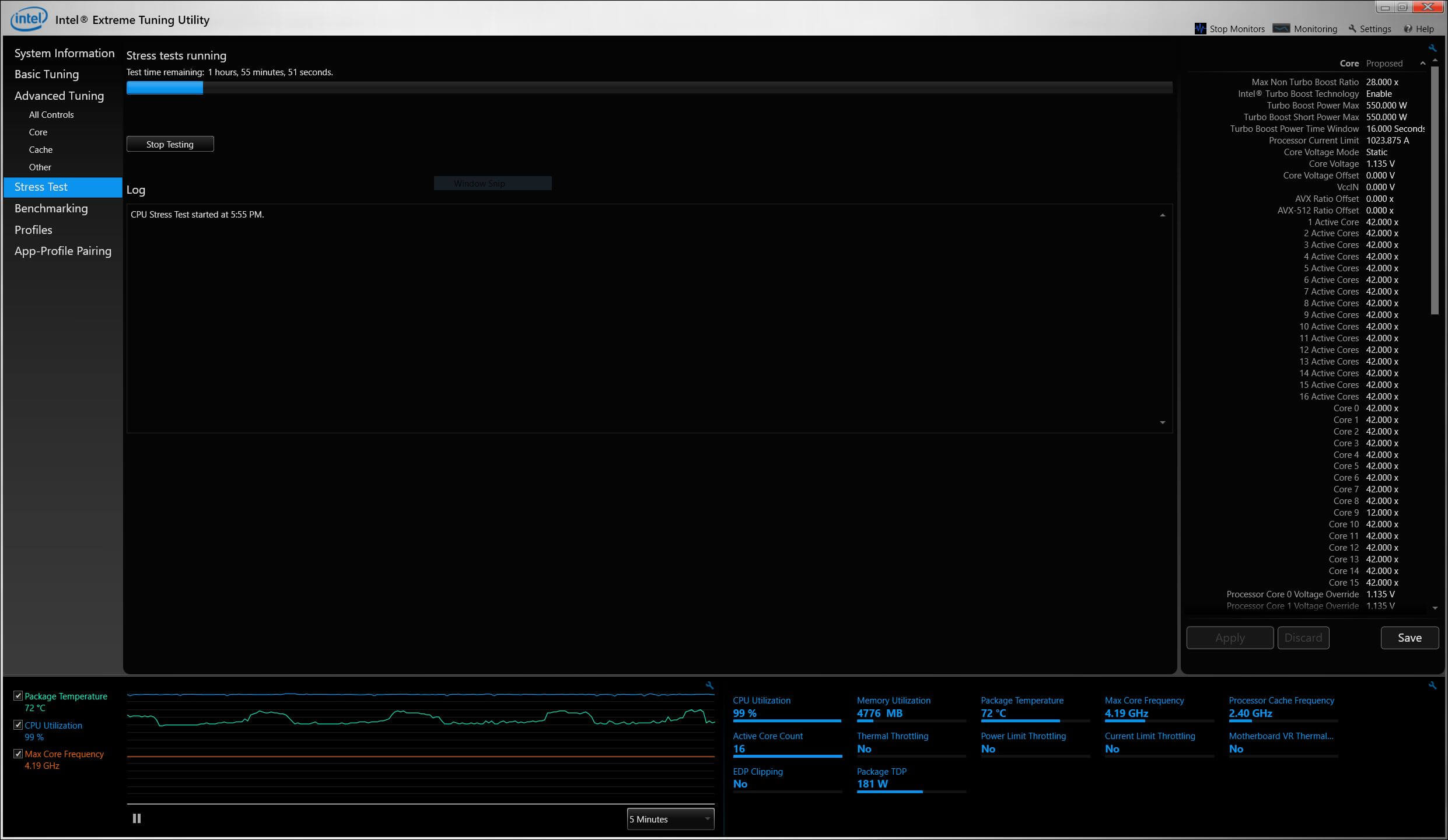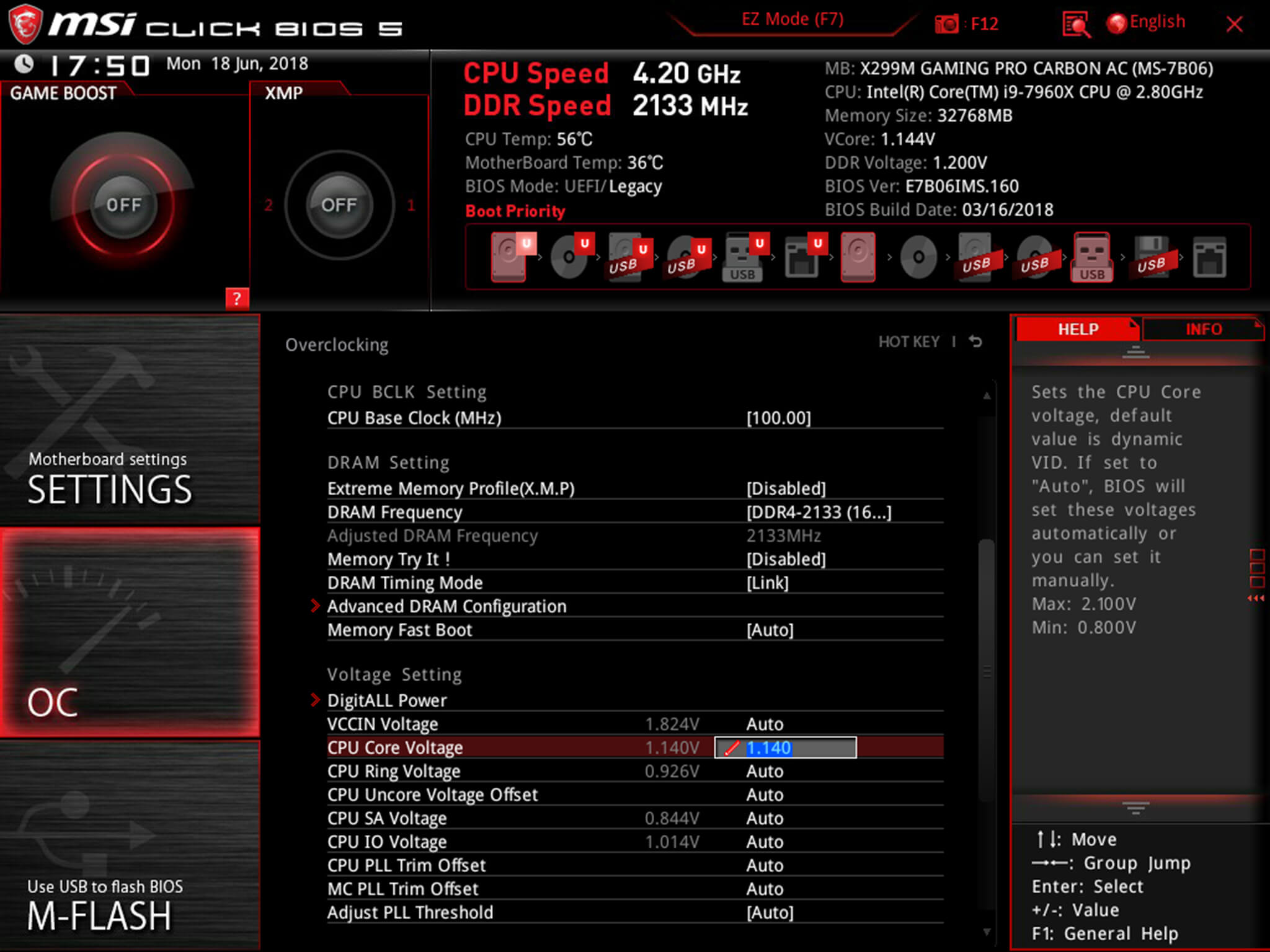The core voltage is different for each processor model, and while all CPUs of the same model have the same VID, not all samples maintain stability at the same clock speeds and Vcore due to slight variations in silicon quality. Every sample of the same CPU model is tested to maintain stability at the default speeds and the VID determined by the manufacturer.
Core voltage typically maintains a constant value while your CPU is in use; however, sometimes under heavy workloads vcore can fluctuate. This is known as Vdroop and can be corrected with load-line calibration. This applies additional voltage as load increases to maintain your CPU's stability.
When it comes to overclocking, you can only push your CPU's frequency so far before your CPU starts to experience instability. Programs might begin to crash or hang up, game performance could suffer or your computer could even fail to boot. This is because your processor isn't getting enough voltage to maintain system stability.
Increasing voltage will allow you to dial in the perfect overclock.
To adjust the voltage, you'll need to boot into your motherboard's BIOS and make adjustments there. The Vcore is expressed as a three decimal value, such as 1.235v. By default, the voltage control is set to auto; this can be overridden by typing in any value. Make sure not to exceed the recommended maximum for your processor.

Before fine-tuning the Vcore, it's important to find a good baseline value for a given speed. This varies from model to model but it can be helpful to read reviews for your CPU, specifically ones that focus on overclocking.
Most publications will list the voltage they required to keep several different speeds stable. Every CPU sample is different and you will need to fine-tune the voltage before calling it done; however, these values do provide a good starting point.

If you boot your machine and don't find any stability issues, then you know it's time to start decreasing the voltage. When overclocking, you want to find the lowest voltage required to maintain stability. More voltage equals more heat and this will allow you to keep temperatures under control.

The safest way to adjust voltage is with increments of .01 volts. Decrease voltage until your computer starts showing signs of instability under load. Use a program like Intel's Extreme Tuning Utility (XTU) or Prime95 to stress test your processor.
If the test fails or crashes, then you need to raise the voltage back up to the previous stable point. For optimal efficiency, you can increase the voltage by .005 instead and again test for stability.

Conversely, if your overclock isn't stable at your baseline voltage, you will then need to increase the voltage until your computer shows no adverse effects and then decrease in increments of .005 to fine tune.

Overclocking is not the only time it can be useful to adjust voltage. As mentioned, higher voltage levels cause your CPU to generate more heat, regardless of frequency. Some CPU samples may have a higher VID than is actually required at the default frequency. Undervolting your processor allows your to maintain stability while decreasing temperatures and extending the life of your processor.
It's a common misconception that disabling Turbo Boost is a more effective substitute for shedding heat. While this does result in decreased temperatures, it is not an alternative as the purpose of undervolting is to maintain the same level of performance while generating less heat. When making adjustments, the same principles apply here as with overclocking, decrease Vcore in increments of .01 and then fine tune with adjustments of .005.
 Police on night patrol find huge snake, wait for it to cross the road
Police on night patrol find huge snake, wait for it to cross the road
 Why the heat wave hitting the Western U.S. is so intense
Why the heat wave hitting the Western U.S. is so intense
 Facebook's Oculus is testing in
Facebook's Oculus is testing in
 Shop the Shark FlexStyle for 20% off at Amazon
Shop the Shark FlexStyle for 20% off at Amazon
 Can you use Bitcoin on Amazon for Prime Day, or nah?
Can you use Bitcoin on Amazon for Prime Day, or nah?
 Everyone can relate a little too well to this insane ice skating fail
Everyone can relate a little too well to this insane ice skating fail
 Google app is crashing for many users today. Here's a fix.
Google app is crashing for many users today. Here's a fix.
 Fyre Festival and Trump’s Language
Fyre Festival and Trump’s Language
 DO NOT give access to that app promising a baby pooping video
DO NOT give access to that app promising a baby pooping video
 Researchers map the koala genome in the name of saving the species
Researchers map the koala genome in the name of saving the species
 How to cancel your Disney+ subscription
How to cancel your Disney+ subscription
 How to cancel your Disney+ subscription
How to cancel your Disney+ subscription
 'Loki' episode 3 slows down to lay some sneaky groundwork
'Loki' episode 3 slows down to lay some sneaky groundwork
 Best tablet deal: Save $45 on Amazon Fire HD 10 tablet
Best tablet deal: Save $45 on Amazon Fire HD 10 tablet
 Doug Jones won Alabama and people are so, so happy
Doug Jones won Alabama and people are so, so happy
 Inventor of the World Wide Web is auctioning its source code as an NFT
Inventor of the World Wide Web is auctioning its source code as an NFT
 Sexual abuse in the music industry gets spotlight with #MeNoMore
Sexual abuse in the music industry gets spotlight with #MeNoMore
 'Severance' puts a spin on the Orpheus and Eurydice myth in its Season 2 finale
'Severance' puts a spin on the Orpheus and Eurydice myth in its Season 2 finale
 'Cruella' has a great soundtrack — there's just way too much of it
'Cruella' has a great soundtrack — there's just way too much of it
Uber tries to appease drivers with more app featuresYouTube reportedly considering overhauls to kids contentUber tries to appease drivers with more app featuresFacebook cofounder says the company's cryptocurrency plans are 'frightening'A woman fell asleep on her flight, then woke up to an empty planeShould you put your zodiac sign in your online dating profile?Enjoy 2016 reimagined in gingerbread form'Minecraft' at E3 2019: New games promise a new vision for MinecraftIKEA's website lets you build the perfect couch and Twitter has ideasThere's a hidden easter egg on J.K. Rowling's new websiteWaymo's autonomous cars will drive outside the US for the first timeEnjoy 2016 reimagined in gingerbread form5 negotiating tips girls can learn for a brighter futureAsk the experts: 9 books that will help you stand up for equality in 2017Future air travel at the Paris Air Show looks highWalmart's using AIRogue kangaroo smashes through a window and onto a sleeping couple's bedThe inventor of the USB sees our pain and explains their designYou can bet on pugs racing in Christmas costumes to brighten your dayThe inventor of the USB sees our pain and explains their design 10 books to read during the #MeToo era Essential is working on getting rid of the notch Ariana Grande inspires beautiful social media movement of self Australia's Defence department bans messaging app WeChat Hollywood's scariest supercomputer joins the Amazon Alexa family The Nintendo Switch is the best console for gaming in comfort Third nor'easter in 3 weeks to hit New England: What's going on here? Activists and families of gun violence victims protest with 7,000 shoes on Congress' doorstep Jeff Goldblum brings Dr. Ian Malcolm to 'Jurassic World Evolution' From space, the third nor'easter in 2 weeks is seen pummeling Boston Girl texts a wrong number and receives compliments from a big family of strangers Stranger Things' creators respond to on Apple patents a crumb How a sketchy cryptocurrency mining app got into the Mac App Store Actress Janet McTeer on her game How come Queer Eye's Antoni smells weird sh*t every episode Dancer rides white horse onto nightclub floor, chaos ensues in Florida James Blunt just came for John Mayer with a hilarious tweet Scientists find rare type of ice, dubbed Ice Everything you need to know about the National School Walkout
2.3119s , 10133.3828125 kb
Copyright © 2025 Powered by 【Passion's Peak (2002)】,Steady Information Network